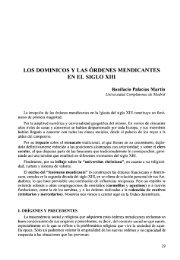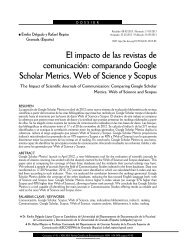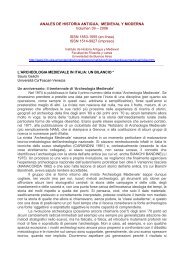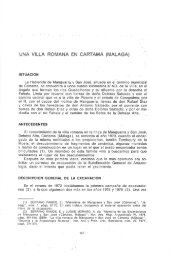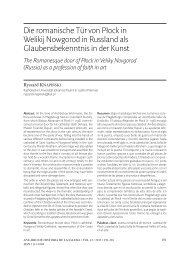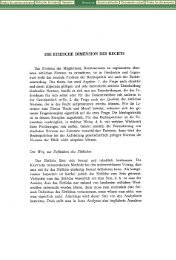Roslyn M. Frank 1.0. Introduction In the first chapter of this ... - Dialnet
Roslyn M. Frank 1.0. Introduction In the first chapter of this ... - Dialnet
Roslyn M. Frank 1.0. Introduction In the first chapter of this ... - Dialnet
Create successful ePaper yourself
Turn your PDF publications into a flip-book with our unique Google optimized e-Paper software.
96 <strong>Roslyn</strong> M. <strong>Frank</strong><br />
Although <strong>the</strong> significance <strong>of</strong> <strong>the</strong> findings <strong>of</strong> genetics is multifaceted, in <strong>the</strong><br />
context <strong>of</strong> <strong>this</strong> <strong>chapter</strong> <strong>the</strong>re are specific aspects <strong>of</strong> <strong>the</strong> research that need to<br />
be highlighted. As I mentioned earlier, <strong>the</strong> Near Eastern genetic component,<br />
associated by many investigators with processes <strong>of</strong> demic diffusion, is no longer<br />
considered to be as statistically significant as it was when Ammerman and<br />
Cavalli-Sforza (1984) <strong>first</strong> published <strong>the</strong>ir results. <strong>In</strong>stead, <strong>the</strong> genetic makeup<br />
<strong>of</strong> Europeans is now viewed as having two main components, one older than<br />
<strong>the</strong> o<strong>the</strong>r. Moreover, as noted, investigators argue that a major population<br />
expansion occurred in Western Europe during <strong>the</strong> Late Glacial (c. 11-16.000<br />
years ago) as <strong>the</strong> ice sheets retreated and unglaciated areas fur<strong>the</strong>r north became<br />
available for re-settlement.<br />
Phylogeographic analysis using molecular evidence assigns 60% <strong>of</strong> European<br />
mitochondrial DNA lineages (Richards et al. 2000), and an even higher proportion <strong>of</strong><br />
Western European Y-chromosome lineages (Semino et al. 2000), to a population bottleneck<br />
prior to an expansion from southwest to nor<strong>the</strong>rn Europe (Achilli et al. 2004;<br />
Pereira et al. 2005; Rootsi et al. 2004; Torroni et al. 1998; Torroni et al. 2001). (Gamble<br />
et al. 2006)<br />
Gamble et al. (2005: 209) sum up <strong>the</strong> implications <strong>of</strong> <strong>the</strong>se genetic studies<br />
for Renfrew’s Anatolian model:<br />
The growing evidence that <strong>the</strong> major signal in European genetic lineages predates<br />
<strong>the</strong> Neolithic, however, creates serious problems for <strong>the</strong> agriculturalist perspective.<br />
If western Europe was, to a large extent, repopulated from nor<strong>the</strong>ast Iberia<br />
[Pyrenean-Cantabrian zone] <strong>the</strong>n, since place-name evidence suggests that people in<br />
<strong>this</strong> source region spoke languages related to Basque before <strong>the</strong> advent <strong>of</strong> <strong>In</strong>do-European,<br />
<strong>the</strong> obvious corollary would seem to be that <strong>the</strong> expanding human groups should<br />
have been Basque speakers.<br />
If we take <strong>this</strong> last statement by Gamble et al. seriously, it elicits to two<br />
inter-related questions. The <strong>first</strong> was formulated recently by <strong>the</strong> geneticist<br />
Richards (2003: 135), namely, who are <strong>the</strong> «Europeans»? The second one<br />
was posed initially in <strong>the</strong> nineteenth century: who are <strong>the</strong> «<strong>In</strong>do-Europeans»?<br />
From one point <strong>of</strong> view, <strong>the</strong> <strong>first</strong> question has no linguistic counterpart.<br />
But keeping in mind <strong>the</strong> recent findings concerning <strong>the</strong> Pyrenean-<br />
Cantabrian refugium, <strong>the</strong>re is a hint that <strong>the</strong> Basque language could shed<br />
light on <strong>the</strong>se deeper time depths. <strong>In</strong> <strong>the</strong> case <strong>of</strong> <strong>the</strong> second question, for<br />
most researchers today <strong>the</strong> term «Proto-<strong>In</strong>do-European» is no longer<br />
conflated with some unified linguistic system; nor is it equated with some<br />
cohesive population <strong>of</strong> reified speakers, dating back to <strong>the</strong> Bronze Age or<br />
beyond. For example, Zvelebil and Zvelebil (1988) have emphasized that



